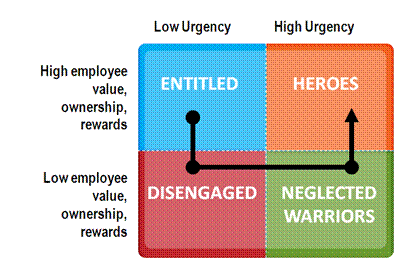 The upcoming war for talent is different because the people pipeline has changed. Instead of an outright war, smaller, less conspicuous battles will be waged for a new class of people: the neglected warriors of the recession.
The upcoming war for talent is different because the people pipeline has changed. Instead of an outright war, smaller, less conspicuous battles will be waged for a new class of people: the neglected warriors of the recession.
These people are likely to be recruited away from their current jobs and quickly transformed into hero status. These heroes will help their organizations thrive as the pace of change continues to escalate.
The HR job in the upcoming war for talent will be focused on transforming neglected warriors into heroes. That work involves one thing: recognition.
Heroes are not necessarily the best employees; they are the people who worked hard to save their organizations in the recession, and in exchange, they are applauded for their deeds.
Neglected warriors are people who harnessed their internal energy to successfully drive many initiatives forward during the recession. However, unlike heroes, with their good deeds came little or no recognition.
Today leaders can sit by and watch as neglected warriors are poached away, or they can be proactive and try to keep them. Our research shows that being proactive now requires HR metrics and processes to find the neglected warriors and take action before it’s too late.
Neglected warriors are at high risk of being poached
The subset of neglected warriors was discovered through employee engagement research conducted via the Leadership Pulse™ and numerous case studies. Neglected warriors are employees with a high sense of urgency, are compelled to move forward, have supported their companies through the recession, and who today find themselves unrecognized and unappreciated for their efforts.
These neglected warriors are at risk of being poached away by the companies who know how to find them and who appreciate the type of talent they possess. The diagnostic tool (called Valour™) used in the Winter 2010 Leadership Pulse study provides an estimate of the prevalence of neglected warriors.
Introduction to the Valour™ diagnostic tool
The Valour tool is an employee engagement survey or performance diagnostic tool. The questions were derived from a large-scale, multi-year research study on the factors that predict long-term stock price growth, earnings growth, and firm survival. The original question set was 200 questions, and via numerous validation studies, the number of items was reduced to 15.
The word “Valour” is an acronym that defines the key parts of the survey. The definition of the word valour is: “Strength of mind and spirit that allows one to conquer danger with firmness.”
The four major components of the Valour survey are:
Val = value, that employees feel valued by their manager and peers
O = sense of ownership in the job and organization
U = sense of urgency
R = rewards, that they are fair and related to performance.
Valour focuses on the “engaged in what?” question by diagnosing the percent of employees moving the company forward or keeping it “standing still.” This is done via the interaction effect predicting performance, which tells the story about the “conditions under which” improving scores is good or bad for performance.
The 2 x 2 matrix in Figure 1 (above) plots the results of the interaction effect (see arrows for direction of intervention needed to improve performance. Improving only the Val-O-R scores for the entitled makes them even more entitled, and for the disengaged, without simultaneously increasing sense of urgency, moves employees from disengaged to entitled. It is much harder to instill a sense of urgency than it is to influence value, ownership and rewards. And in order to move the entitled group, they need to know that their current performance level is not rewarded (thus, move them down on value, ownership and reward).
If successful, moving these groups down on Val-O-R will increase their sense of urgency and allow for positive progression. The neglected warrior class, however, is different. They have a high sense of urgency; they are moving forward, but they need to be appreciated. Our work finds that small efforts can move these individuals from neglected warrior to hero (or fully engaged) status.
Winter 2010 Leadership Pulse survey results
How are managers and leaders doing today? In order to answer this question, we ran the Valour survey with the Leadership Pulse sample. The results for the 470 people who took the Winter 2010 Survey are in Figure 2 (below). The 470 represent all industries studied except mining (using the North American Industry Classification system); they come from small, medium and large organizations; they report being in a representative sample of functional areas, and they are primarily in senior management and leadership jobs.

Figure 2 (right) shows that:
- Some 6 percent of the sample reported being in the entitled group;
- 55 percent are fully engaged or heroes;
- 17 percent are disengaged, and;
- 22 percent are the neglected warriors.
These neglected warriors are the employees at high risk of being poached because they have no good reason to stay with their current organizations. They are visible to other employees because they have a high sense of urgency; they have been on the front lines fighting to keep the organization moving forward in tough times.
Where the Battle Begins
We examined subgroups of the population to find pockets with a high percentage of neglected warriors. The Leadership Pulse data show that people in the age group 36 to 40, in firms with from 25,000 to 50,000 employees reporting average or below average performance, and in information technology or marketing jobs, have higher percentages of people in the neglected warrior classification.
Also, in terms of job level the director and manager/supervisor levels reported higher numbers. We have found consistent patterns in our case study research.